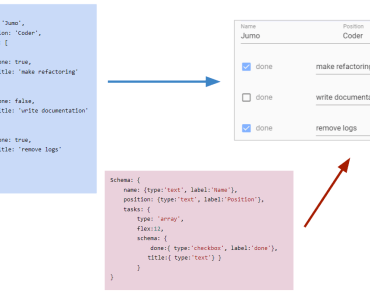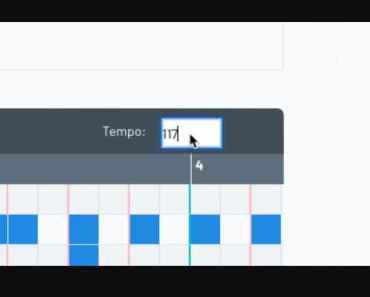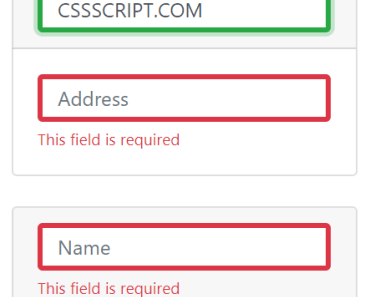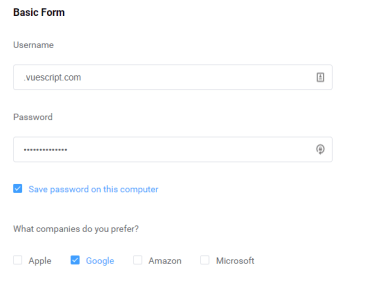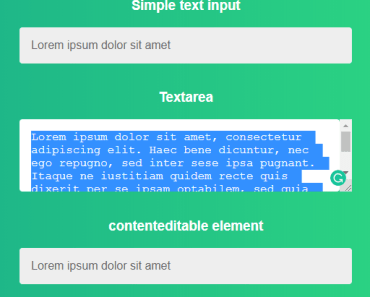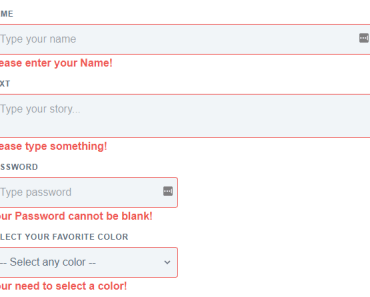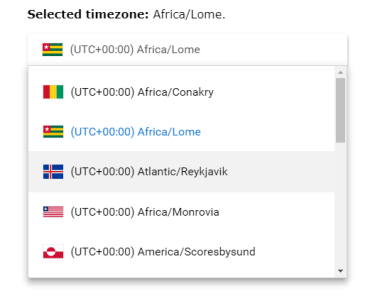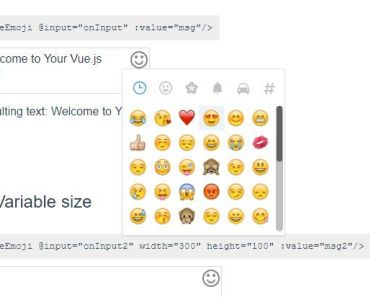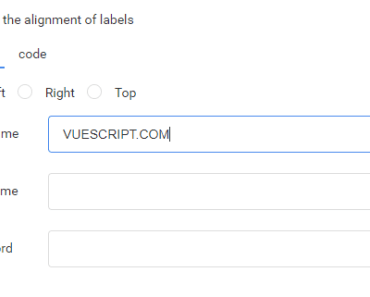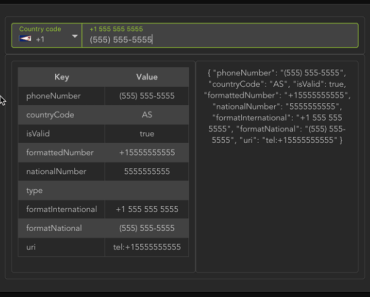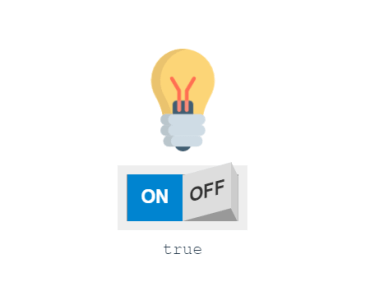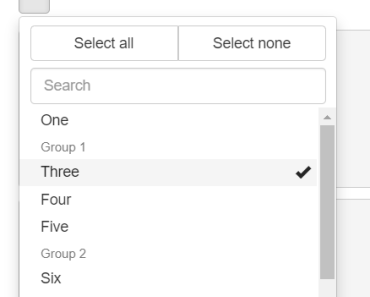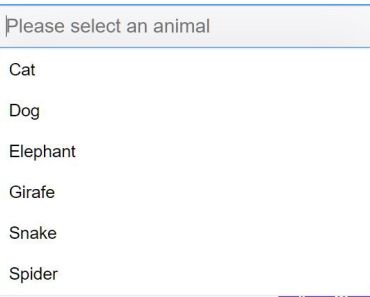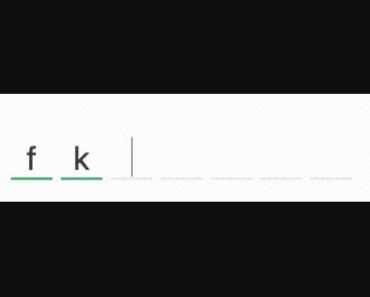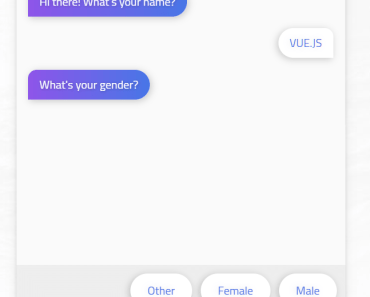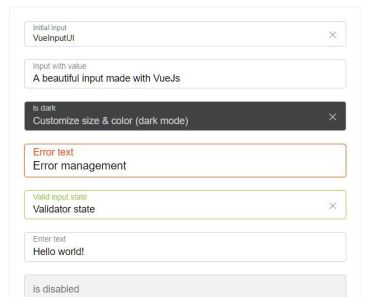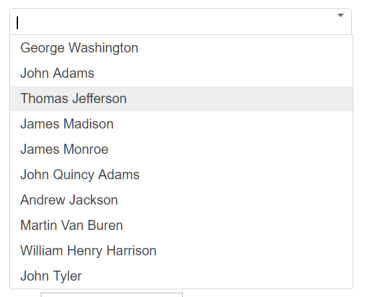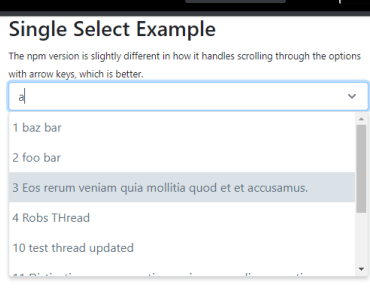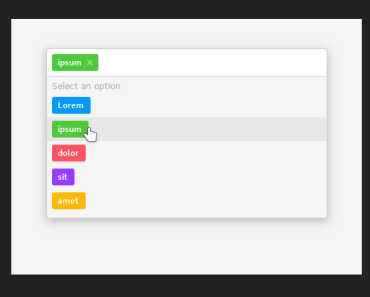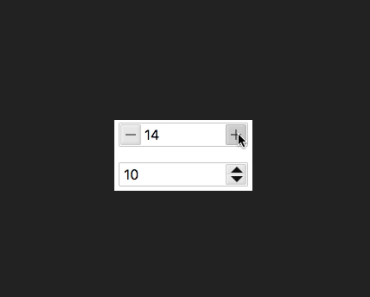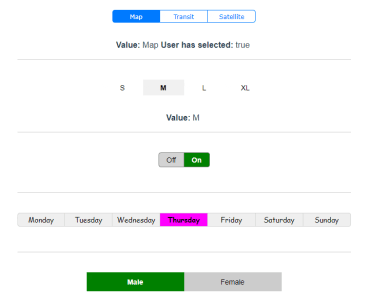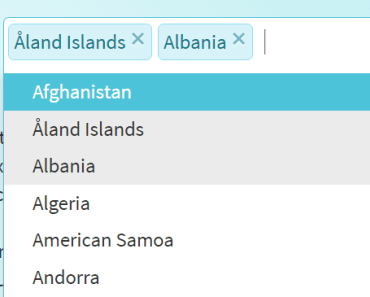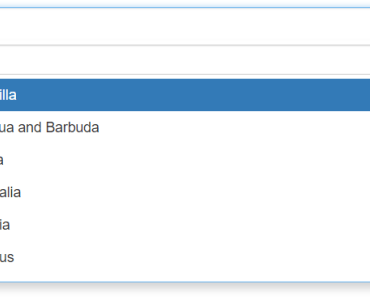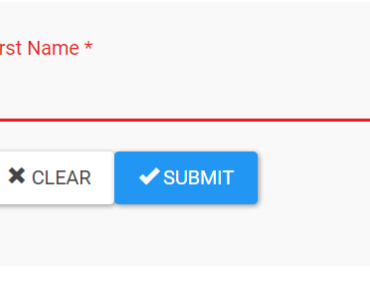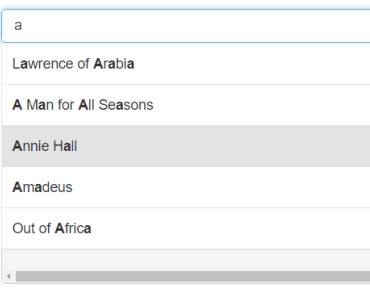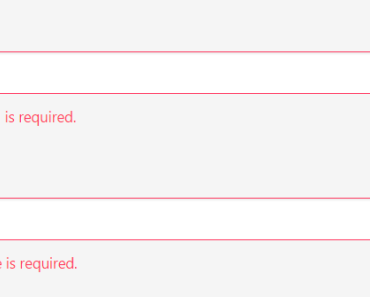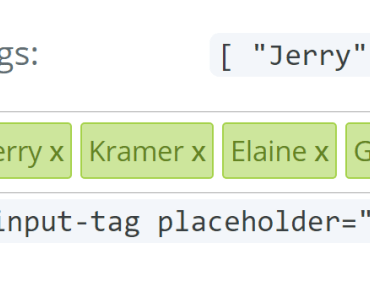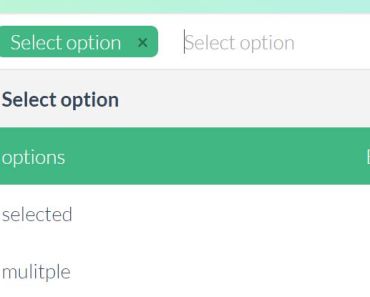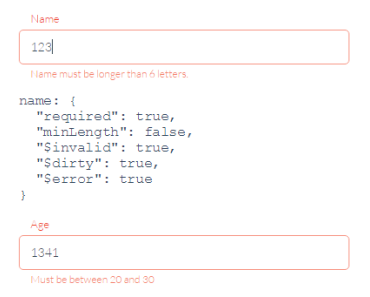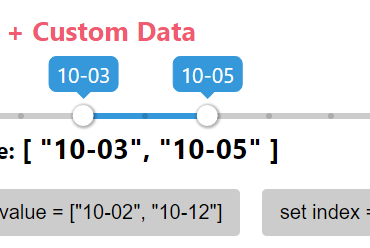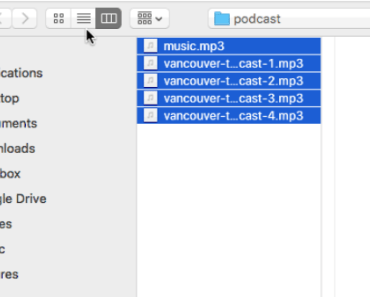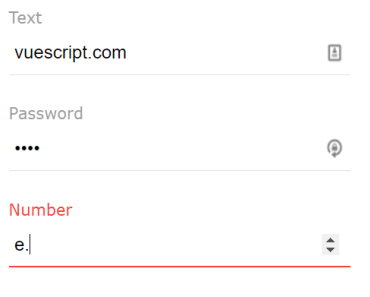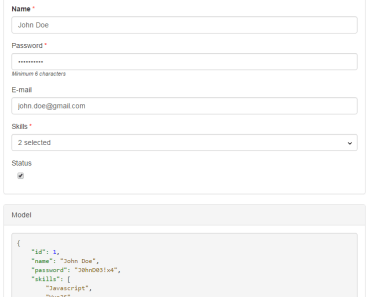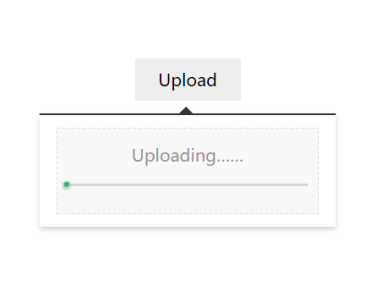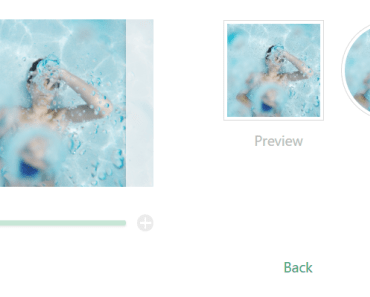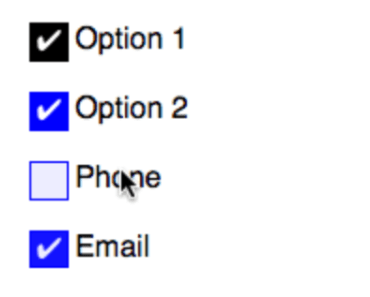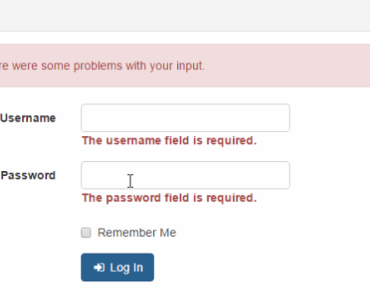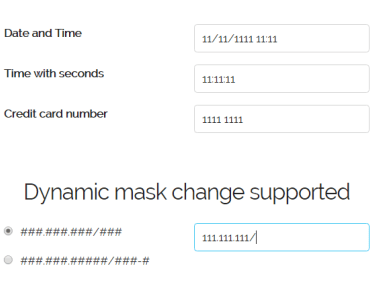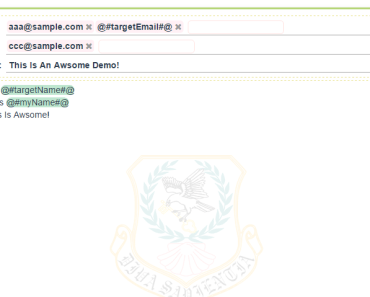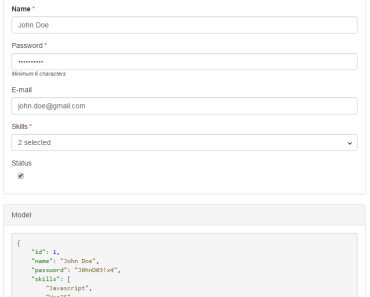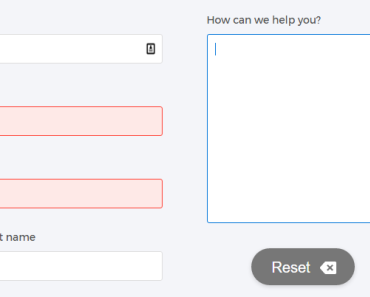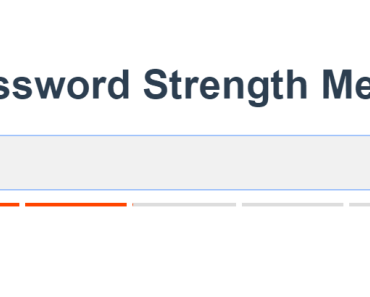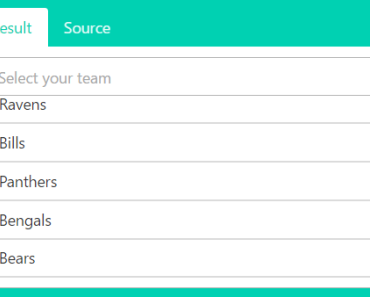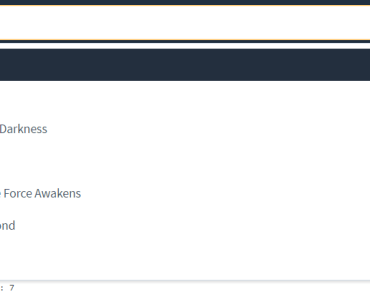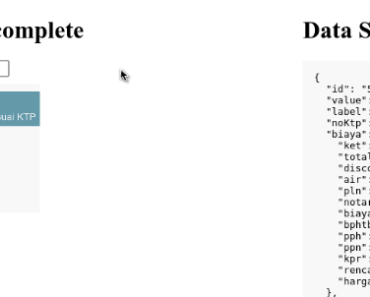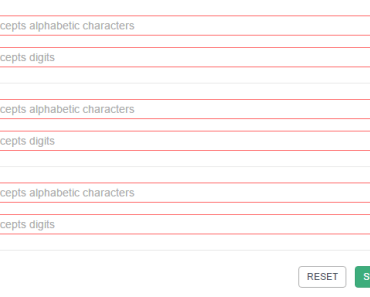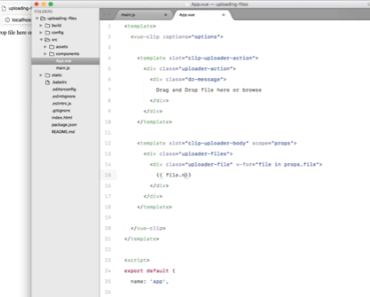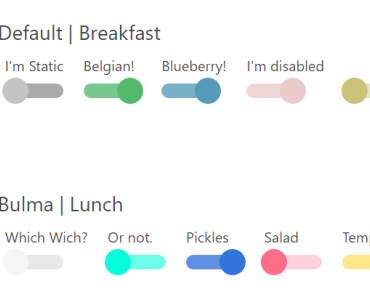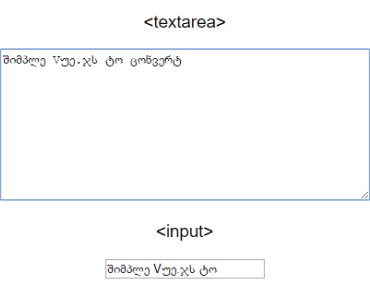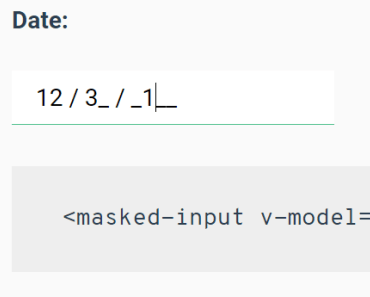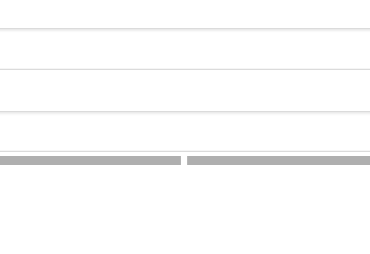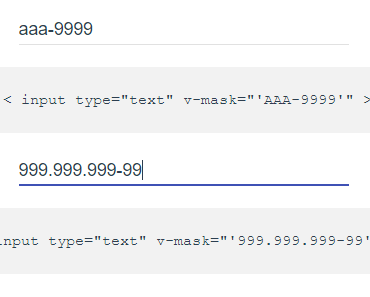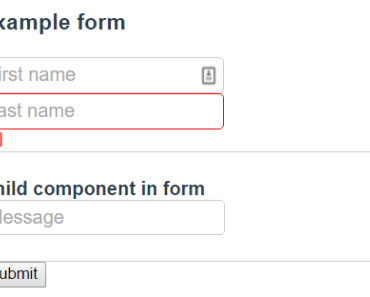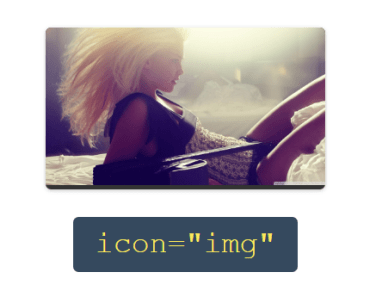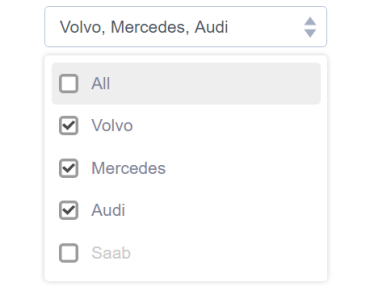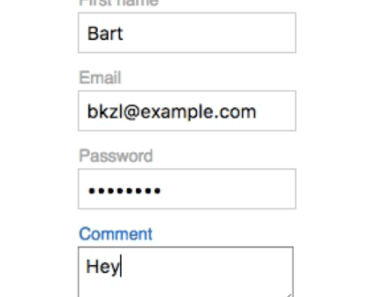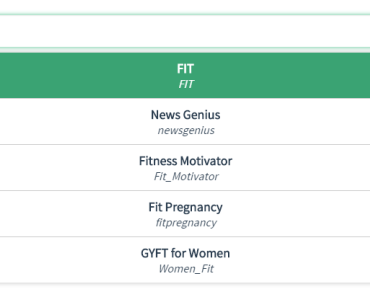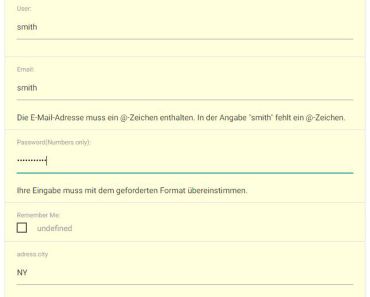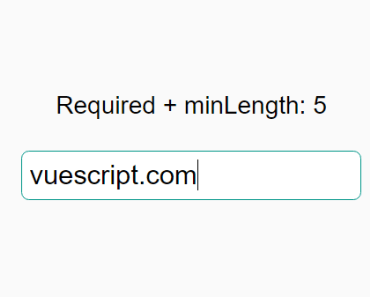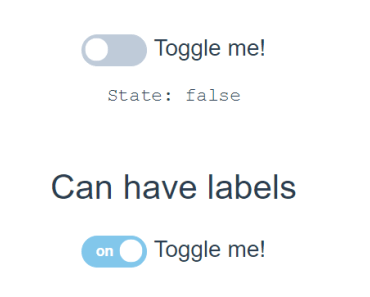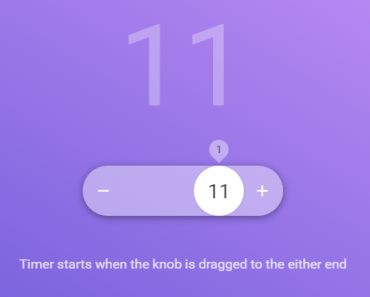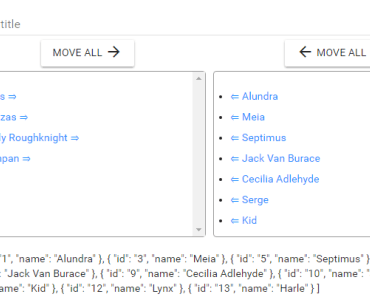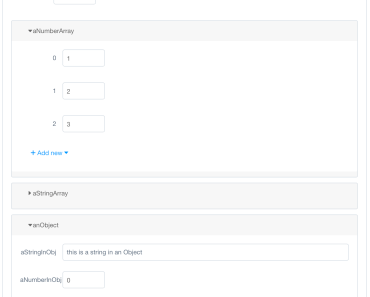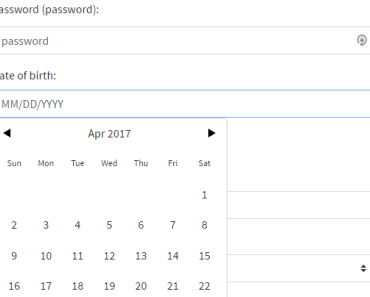Vuetify-Form-Base
Imagine you get the following data object in JSON format and have to edit it now.
Value: { name: 'Jumo', position: 'Coder', tasks: [ { done: true, title: 'make refactoring' }, { done: false, title: 'write documentation' }, { done: true, title: 'remove logs' } ] } Normally you have to flatten the data structure and then map all to an appropriate form. Then you have to define a HTML-Form and animate it with your data.
With Vuetify-Form-Base create a Schema Object with the same structure as your Data.
Schema: { name: {type:'text', label:'Name', flex:{ xs:12, sm:6 } }, position: {type:'text', label:'Position', flex:{ xs:12, sm:6 } }, tasks: { type: 'array', flex:12, schema: { done:{ type:'checkbox', label:'done', flex:3}, title:{ type:'text'}, flex:9 } }, } and you will get a full reactive, editable Form:
You have to create a lot of different Forms? You have to manipulate or edit Data presented in JS-Objects?
Then give Vuetify-Form-Base a Try. This Schema-based Form Generator is a Vue.js 2.0 Component and can simplify your Job by automatically creating full editable Forms. Edit this Forms and get reactive Results.
Vuetify-Form-Base uses the well known Component Framework Vuetify to style and layout your Form. Vuetify Controls have a clear, minimalistic design, and support responsive Design.
Demo
or
Download Project, change current directory to ../vuetify-form-base/example and then run
npm install
npm run serve
Intro
vuetify-form-base is a Vue Component and can easily integrated into any Vue Project.
The Schema-Object has the same structure as the Value-Object. Create a Schema by cloning the Value-Object and replace the Values of the Data-Object by Definitions for your your Schema. The corresponding Schema-Object defines type, layout and functional behaviour of your Form.
The Component Framework Vuetify styles your Form. The Controls have a clear design, but don't worry you can change your style in a lot of ways. For more details see section Style with CSS
Based on an existing Value-Object vuetify-form-base generates a full editable Form. Layout and Functionality are defined in a Schema-Object, which has the same Property structure as the Value-Object. Your Data-Object keeps full reactive and any Input or Change in your Form triggers an Event too. If you have a deep nested Value-Object or an Array -Structure you can direct work on it. There is no need to flatten or modify your Data-Presentation.
Changing any Field in the Form gives you a reactive Result in your Value-Object. Furthermore you can synchronize two or more Forms by using same Value-Object.
If you want a Partial-Form which displays only parts of your Data.Object, then link a property of your Data-Object to your vuetify-form-base Component.
And if necessary you can also build a Form in Form by using Slots.
Use the v-on directive of Vue.js to listen to Formbase triggered Events for 'Resize', 'Focus', 'Input', 'Click' and 'Swipe'. Listening to 'Update' will catch all Events.
Select Types from Vuetify UI Input & Controls like Textfield, Password, Email, Textarea, Checkbox, Radio, Switches, Sliders, Combobox, Autocomplete, Select, Combobox, Date- or Timepicker. There are some other types like 'array' and 'list'.
More Informations to Vuetify Textfields find here.
Installation
For proper working you need a Vue.js Project with Vuetify installed. For more Details see Vuetify Quickstart.
npm install vuetify-form-base --save vuetify-form-base is a Vue.js single-file component with a .vue extension and you can use it like any Vue-Component.
In order for your application to work properly, you must wrap it in a v-app component. This component is required and can exist anywhere inside the body, but must be the parent of ALL Vuetify components. v-content needs to be a direct descendant of v-app.
<template> <v-app> <v-content> <v-container fluid> <v-form> <v-form-base :value="myValue" :schema="mySchema" /> </v-form> </v-container> </v-content> </v-app>> </template> import VFormBase from 'vuetify-form-base'; export default { components:{ VFormBase }, data () { return { myValue: { name: 'Jumo', password: '123456', email: '[email protected]', checkbox: true, select: 'Jobs', }, mySchema: { name: { type: 'text', label: 'Name' }, password: { type: 'password', label: 'Password' }, email: { type: 'email', label: 'Email' }, checkbox: { type: 'checkbox', label: 'Checkbox' }, select: { type: 'select', label: 'Select', items: ['Tesla', 'Jobs', 'Taleb'] } } } } } and you will get a full editable Form based on your schema and filled with your Value-Object.
INFORMATION:
Properties in 'myValue' without corresponding Prop in 'mySchema', are ignored and keep untouched, but a initial warning will be logged to console
Example displaying nested Data-Object
In Reality sometimes you will have deep nested objects or arrays, which should be edited. vuetify-form-base works for you and flatten internally this nested object and build a plain Form.
myValue: { name: 'Base', controls:{ selection:{ select: 'Tesla', selectM: ['Jobs'], }, switch: [ true,false ], checkbox: [ false, true, { checkboxArray: [ true, false ]} ] } }, mySchema: { name: { type: 'text', label: 'Name'}, controls:{ selection:{ select: { type: 'select', label: 'Select', items: ['Tesla', 'Jobs', 'Taleb'] }, selectM: { type: 'select', label: 'M-Select', multiple:true, items: ['Tesla', 'Jobs', 'Taleb']} }, switch: [ { type: 'switch', label: '1' }, { type: 'switch', label: '2' } ], checkbox: [ { type: 'checkbox', label: 'A' }, { type: 'checkbox', label: 'B' }, { checkboxArray: [ { type: 'checkbox', label: 'C-A', color:'red' }, { type: 'checkbox', label: 'C-B', color:'red' } ]} ], } } Example editing Data-Arrays
For editing arrays use the type 'array' and define an nested 'schema' property.
mySchema: { tasks: { type: 'array', schema: { done: { type: 'checkbox' }, title: { type: 'text' } } } } Type Array - Schema object
myValue: { tasks: [ { done: true, title: 'make refactoring' }, { done: true, title: 'write documentation' }, { done: true, title: 'remove logs' } ] }, mySchema: { tasks: { type: 'array', schema: { done: { type: 'checkbox', label: 'Ok', flex: 3 }, title: { type: 'text', flex: 8 }, } } } Computed Schema
IF you want Schema Properties to be changed dynamic, then you must make your Schema Object a computed property. This Example turns the Radio Layout from Column to Row on Resizing to medium Size or greater.
data () { return { myValue: { radio: 'A', } } }, computed: { mySchema(){ return { radio: { type: 'radio', row: this.row, options:['A','B'] } } }, row () { return this.$vuetify.breakpoint.mdAndUp } }, Vuetify Layout and Grid
Integrate Vuetify Grid by using the Schema-Properties 'flex', 'offset' and 'order':
mySchema: { name: { type: 'text', flex: 4, offset: 2, order: 1 }, } flex: 4 // shorthand for flex: { xs:4 } offset: 2 // shorthand for offset: { xs:2 } order: 1 // shorthand for order: { xs:1 } A more responsive Solution with 'flex', 'offset' or 'order' needs an Object as Value. For more Details see Vuetify Documentation:
Vuetify - Grid: flex: { xs:12, sm:8, md:6, lg:4 }
Vuetify - Offset: offset: { xs:0, sm:1, md:2, lg:2 }
Vuetify - Order: order: { xs:1, sm:1, md:2, lg:2 }
Link & Synchronize
Forms can be linked together using the same Value-Object. Changes in one Form are synchronized and reflected in the other Form.
<v-form-base :value="myValue" :schema="mySchema" /> <v-form-base id="form-sync" :value="myValue" :schema="mySchema" /> Vuetify Controls API-Props
Vuetify Controls have a API with Props These Props in Vuetify-Controls comes in kebab-case amd must for use in Schema-Object converted to CamelCase
<!-- vuetifyjs.com --> Input & Controls Text-fields API-Props append-icon background-color <!-- JS --> mySchema: { name: { type:'text', appendIcon:'menu', backgroundColor': 'red' }, ... } Schema
<form-base :schema="schema" ... /> Schema is an JS-Object, which defines and controls the behavior of your Form. Each Key Prop) in your Schema-Object must reflect a Key from your Data-Object. A minimalistic Definition of a text input could look like this:
schema:{ name: { type:'text'} } The next shows a more complex Schema:
// Partials Functions for Rules const minLen = l => v => (v && v.length >= l) || `min. ${l} Characters` const maxLen = l => v => (v && v.length <= l) || `max. ${l} Characters` const required = msg => v => !!v || msg const validEmail: msg => v => /.+@.+\..+/.test(v) || msg // Destruct Value and return a Value! const toUpper = ( {value} ) => value && value.toUpperCase() export default { components: { VFormBase }, data () { return { myValue: { name: 'Base', password: '123456', email: '[email protected]' }, mySchema: { name: { type: 'text', label: 'Name', hint:'Converts to UpperCase' toCtrl: toUpper, fromCtrl:toUpper, rules: [ required('Name is required<>) ] flex: 12, }, password: { type: 'password', label: 'Password', hint:'Between 6-12 Chars', appendIcon: 'visibility', counter: 12, rules: [ minLen(6), maxLen(12) ], clearable: true, flex: 12 }, email: { type: 'email', label: 'Email', rules: [ validEmail('No valid Email'), required('Email is required<>) ], flex: 12 } } } } } Available Properties in Schema
For further Props see Vuetify Controls API
schema:{ type: string // text, password, email, radio, switch, slider, // combobox, autocomplete, select, combobox, date, time, ... sort: N // use simple order to display items order: N or Object // use Vuetify-Grid to order items responsive flex: N or Object // See Vuetify Grid offset: N or Object // See Vuetify Grid label string, // label of item placeholder: string, // placeholder hint: string, // additional Info color: string backgroundColor:string css: string, // inject classnames - schema:{ name:{ css:'small'}, ... } mask: string, // regex to control input multiple: bool, // used by type: select, combobox, autocomplete required: bool, // need an input value hidden: bool, // hide item - set from another item disabled: bool, readonly: bool, appendIcon: icon // click triggers event with icon-location prependIcon: icon // click triggers event with icon-location items: array // ['A','B'] used by type: select, combobox, autocomplete options: array, // ['A','B'] used by type:radio rules: array of Fn // [ value => true || false, ... ] // must return a (modified) value!! toCtrl: function, // ( {value, obj, data, schema} ) => value fromCtrl: function, // ( {value, obj, data, schema} ) => value } Events
We can use the v-on directive to listen to vuetify-form-base events 'focus', 'input', 'click', 'resize', 'swipe', 'update' and run some Code when they’re triggered.
This Example use the Default ID and listen all events with 'update':
<!-- HTML --> <v-form-base :value= "myValue" :schema= "mySchema" @update= "update" /> This has a Custom ID and listen all events in separate methods. Your v-on Directive must append the Custom ID:
<!-- HTML --> <v-form-base id = "form-base-simple" :value= "myValue" :schema= "mySchema" @update:form-base-simple= "update" /> <v-form-base id = "form-base-complete" :value= "myValue" :schema= "mySchema" @resize:form-base-complete= "resizeCode" @focus:form-base-complete= "focusCode" @click:form-base-complete= "clickCode" @swipe:form-base-complete= "swipeCode" @input:form-base-complete= "inputCode" /> The Event-Signature:
update( { on, id, key, value, obj, event, params, size, data, schema } ){ // destructure the signature object // ... on, id, key, value, obj, event, params, size, data, schema } on - Trigger Name // focus | input | click | resize | swipe or update to listen all id - Formbase-ID key - key of triggering Element value - value of triggering Element obj - triggering Element { key, value, schema } params - params object if available { x, y, pos, icon } event - the native trigger-event if available data - Data-Object schema - Schema-Object Example: Use 'Update' Event to control Visibility of Password Element
<!-- HTML --> <v-form-base :value="myValue" :schema="mySchema" @update="update"> <!-- JS --> // Schema mySchema: { password:{ type:'password', appendIcon:'visibility', .... } } ... update ({ on, key, obj, params }) { // test event is 'click' and comes from appendIcon on key 'password' if (on == 'click' && key == 'password' && (params && params.pos) == 'append') { // toggle icon obj.schema.appendIcon = obj.schema.type === 'password' ? 'lock' : 'visibility' // toggle visibility obj.schema.type = obj.schema.type === 'password' ? 'text' : 'password' } } Slots
Use Slots to pass Header and Footer into a Control. If necessary replace Controls by Slots. Any slot could be a v-form-base component itself.
<v-form-base :value="myValue" :schema="mySchema" @update="update"> <h4 slot="slot-top-key-name">Top Slot on Key Name</h4> <h4 slot="slot-top-type-radio">Top Slot on Types Radio</h4> <h4 slot="slot-item-key-password">Slot replaces Key Password</h4> <h4 slot="slot-bottom-key-name">Bottom Slot Key Name</h4> <h4 slot="slot-bottom-type-radio">Bottom Slot on Types Radio</h4> </v-form-base> Form Validation
If you need Form Validation you have to wrap v-form-base with v-form and take the reference of v-form for working on.
<!-- HTML --> <v-form ref="form" v-model= "formValid" lazy-validation> <v-form-base :value= "myValue" :schema= "mySchema" @update= "update"/> </v-form> <!-- JS --> validate () { this.$refs.form.validate() }, resetValidation () { this.$refs.form.resetValidation() }, Style with CSS
Customize your vuetify-form-base component using CSS-Classnames
IMPORTANT:
Don't use<style scoped>in parents component, because scoped definitions are inside the child component not accessable
Formbase - ID
#form-base is the default ID of your component. If you need different CSS for two or more forms in the same parent component, then change default value by setting a different ID for each component and use this new ID. Using a 'custom-id' you have to modify the event-binding to @update:custom-id = "update"
<!-- Default ID CSS-Style --> #form-base {...} <!-- HTML-Template --> <v-form-base @update= "update" /> <!-- Custom-ID CSS-Style --> #custom-id {...} <!-- HTML-Template --> <v-form-base id="custom-id" @update:custom-id= "update" /> General - Classname
#form-base {...} Type - Classnames
Style all items of a specific type, then use type specific classnames. They start with type- appended by any type. You can use following types in your Schema-Object:
'text', 'email', 'password', 'textarea', 'select', 'autocomplete', 'combobox', 'radio', 'checkbox', 'slider', 'switch', 'date', 'time'
#form-base .type-text { color: #44A }} #form-base .type-email { font-weight:500; } Key - Classnames
Set Classname of deep key in your Data-Object, by converting .dot notation 'person.adress.city' into kebab case 'person-adress-city' prepending 'key-'
<!-- myValue{ person:{ adress:{ city:'',... } ... } ... } CSS Classname to access to key 'city' --> #form-base .key-person-adress-city { font-weight:500; } <!-- Access to myValue: { name:'' } CSS Classname to access key 'name' --> #form-base .key-name { font-weight:500; } <!-- myValue: { controls: { slide: [25, 64] } Access First Entry in Array of Key Slide --> #form-base .key-controls-slide-0 { font-weight:500; } Validate with Pseudoselectors
#form-base .item input:valid { background-color: #afa; } #form-base .type-email input:invalid { background-color: #faa; } #form-base .key-name input:focus { background-color: #ffd; } CSS - Example
<!-- JS --> myValue: { name: 'Base', password: '123456', email: '[email protected]', controls: { checkbox: true, switch: true, slider: 33, radioA: 'A', radioB: 'B' } } <!-- CSS --> <style> #form-base { border: 1px solid #cb2; background-color: #ffe; padding:2rem } /* CSS Item --- set all items */ #form-base .item { border-left: 1px dashed #29D; border-top: 1px dashed #29D; padding:1rem } /* CSS Type --- set all items with type */ #form-base .type-switch { border-bottom: 3px solid #E23} #form-base .type-checkbox { background-color: #fdd } /* CSS Keys --- select key in object 'myValue.controls.slider' */ #form-base .key-controls-slider { background-color: #fec } </style> Features
- Vue-Component
- integrates UI framework Vuetify with responsive Layout and Support of Grid
- Use a lot of Vuetify Control & Input types inclusive available API-Props
- Get full configurable Forms based on Schema Definition
- Edit plain or deep nested objects including Arrays, without the Need to flatten it
- Get a Full reactive Result
- Listen on 'Resize', 'Focus', 'Input', 'Click', 'Swipe' and 'Update' Events
- Use Slots to pass Header and Footer into a Control. Or replace a Control by Slot
- Configurable CSS Style
Dependencies
Vue >= 2.4
Vuetify >= 1.4
Lodash > 4.0
Similar Projects
License
vuetify-form-base is available under the MIT license.
